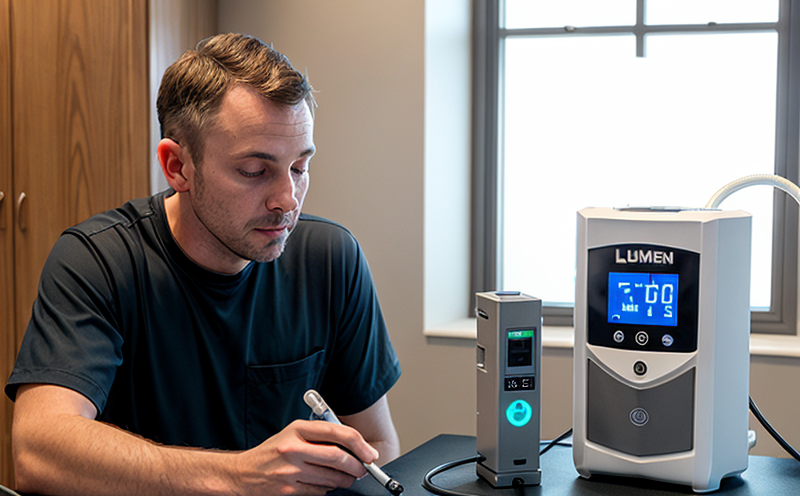Lumen Maintenance & Lifetime Testing
Lighting is a critical component in numerous sectors ranging from residential to commercial and industrial applications. The performance of lighting fixtures over time directly impacts energy efficiency, sustainability goals, and user satisfaction. Lumen maintenance and lifetime testing are crucial for ensuring the longevity and efficacy of light sources, especially as they influence the operational costs and environmental impact. This service ensures that light fixtures maintain their initial brightness levels throughout their expected lifespan, which is essential for compliance with industry standards.
The testing process involves simulating real-world operating conditions to evaluate how well a lighting fixture retains its lumen output over time. This helps in identifying any degradation in performance due to factors such as temperature fluctuations, electrical stress, or environmental exposure. The results of these tests are vital for manufacturers and suppliers who aim to meet regulatory requirements and improve the overall quality of their products.
For quality managers, compliance officers, R&D engineers, and procurement professionals within the lighting sector, understanding lumen maintenance and lifetime testing is paramount. These tests help in predicting the long-term performance of light sources, ensuring that they meet or exceed industry standards such as those set by IEC and ANSI. By conducting these tests early in the product development cycle, manufacturers can make informed decisions about design improvements and material choices.
Lumen maintenance testing is not only important for lighting fixtures but also extends to LED components. LEDs are known for their long lifespan compared to traditional bulbs, but they do experience a phenomenon called "lumen depreciation," where the light output diminishes over time. This depreciation can be accelerated by various factors including heat generation and electrical stress. Understanding this process is crucial for manufacturers aiming to provide reliable products.
The testing apparatus used in lumen maintenance and lifetime testing includes specialized chambers that replicate different environmental conditions, such as high temperatures or humidity, which are known to affect the performance of light sources. These chambers allow for controlled exposure of the fixtures to various stressors, enabling a comprehensive assessment of their durability and reliability.
The acceptance criteria for these tests are strictly defined based on industry standards. For instance, ANSI C82 specifies the test methods for determining lumen maintenance of incandescent lamps, while IEC 60950-1 provides guidelines for safety-related requirements and tests for household and similar general purpose fixed electric equipment.
The results of these tests are reported in terms of percentage lumen maintenance. This metric indicates the ratio of current lumens to initial lumens, offering a clear indication of how much brightness is retained over time. A fixture that maintains 80% of its initial lumen output after the specified test period would be considered to have good lumen maintenance.
By investing in robust lumen maintenance and lifetime testing, manufacturers can enhance their product offerings, meet regulatory requirements more effectively, and build a strong reputation for quality. This service is particularly beneficial for companies operating in sectors such as commercial buildings, industrial facilities, and residential homes where the performance of lighting fixtures plays a significant role.
Why It Matters
Lumen maintenance and lifetime testing are essential because they provide critical insights into the long-term performance of light sources. For manufacturers and suppliers, these tests offer valuable data that can inform design improvements and material choices. By understanding how a fixture behaves under various conditions over time, companies can enhance their products' reliability and durability.
For quality managers and compliance officers, lumen maintenance testing ensures that products meet or exceed industry standards such as IEC, ANSI, and others. This is crucial for maintaining a competitive edge in the market and ensuring regulatory compliance.
R&D engineers benefit from lumen maintenance testing by gaining insights into potential issues that can arise during product development. This information allows them to address these challenges early on, leading to better-performing products. Procurement professionals also find value in this service as they can select suppliers who provide high-quality fixtures with proven performance.
The real-world implications of lumen maintenance and lifetime testing are significant. For instance, a fixture that maintains its brightness over time contributes to energy savings by not requiring frequent replacements. This reduces operational costs for businesses and decreases waste sent to landfills, aligning with sustainability goals.
In the context of commercial buildings, industrial facilities, and residential homes, reliable lighting is essential. Ensuring lumen maintenance through testing helps maintain a high level of illumination, which is important for safety, productivity, and user satisfaction. A well-lit space enhances employee morale and customer experience, leading to improved performance in various settings.
Applied Standards
| Standard | Description |
|---|---|
| ANSI C82 | Test methods for determining lumen maintenance of incandescent lamps. |
| IEC 60950-1 | Safety-related requirements and tests for household and similar general purpose fixed electric equipment. |
| EN 62471 | Specifications for luminaires intended to be used in buildings, tunnels, and other civil structures. |
| ANSI/IESNA Illuminating Engineering Society LM-79 | Test procedures for solid-state lighting products. |
Competitive Advantage and Market Impact
- Enhances product reliability and durability, making them more attractive to buyers.
- Aids in meeting strict regulatory requirements and industry standards, ensuring compliance.
- Improves the reputation of manufacturers by providing high-quality products with proven performance.
- Promotes energy efficiency by reducing the need for frequent replacements, thus lowering operational costs.
- Aligns with sustainability goals by minimizing waste through extended product life cycles.
- Supports R&D efforts in identifying and addressing potential issues early in the development process.





